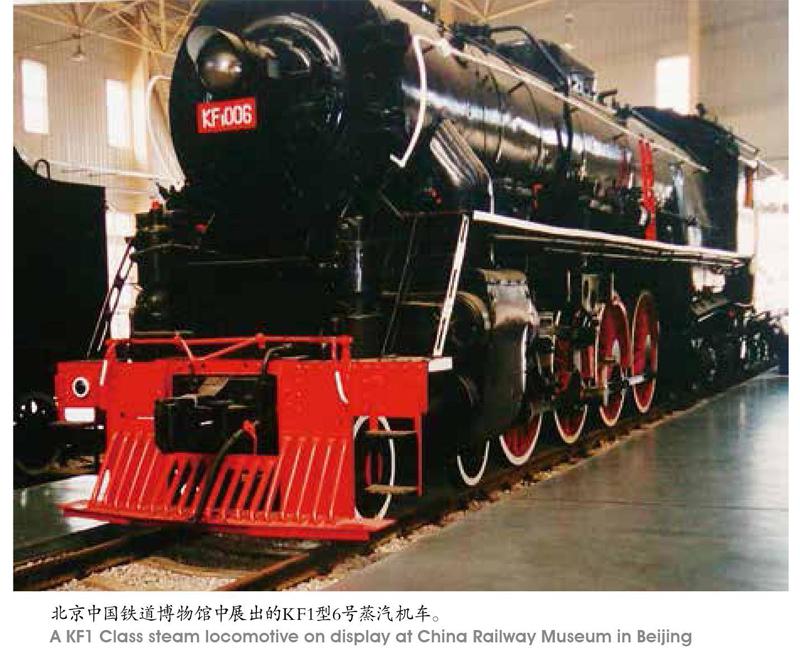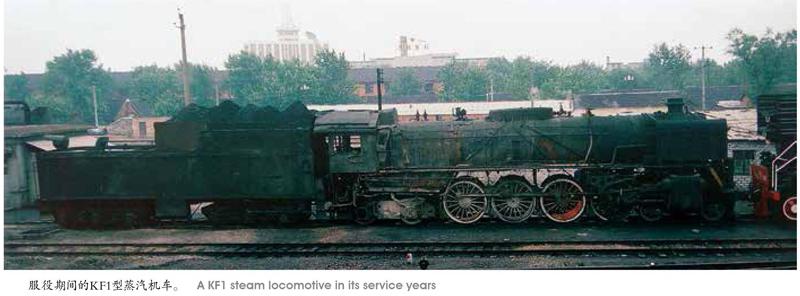凝结两国情谊的一款蒸汽机车
2018-05-09严介生
严介生
两个国家级的铁路博物馆,一个位于中国首都北京,一个坐落在英国的约克郡,各自在展厅的醒目位置陈列着同一款蒸汽机车,分别是“KF1型6”和“KF1型7”,分明是一对“姐妹车”。这是怎么回事?背后又有着怎样的机缘?
中国设计,浙籍工程师发愤图强推出新机车
故事得从上世纪30年代说起。“九一八”事变后,日本加快了扩大侵华战争的步伐,中国政府不得不加紧备战。备战的一个重要举措是,要在4年之内,即于1936年底前建成株洲到韶关间456公里的铁路新线,使33年前张之洞等筹建的京广铁路得以完工,成为一条真正贯通国家南北的大动脉。几经周折,资金算是有了着落。但研究到采购何种机车的时候,问题来了:这段新线的郴州至乐昌间是长江与珠江水系的分水岭,山岗错杂,溪涧迂回,新建的线路坡度大,曲线半径小,桥梁多而且建筑标准低,承载能力差,因而所用的火车头既要功率大,又要自重轻,还须特别灵活,能拐小弯而不翻车。英国是铁路的发源地、蒸汽机车制造强国,却没有一款能够同时满足这些要求的。这使民国铁道部门十分为难,反复讨论之中,一位青年技术人员大胆提出:我们自己设计制造!
这位主张自力更生制造机车的人,名叫应尚才。应尚才是浙江奉化人,1913年清华学堂毕业后公费留学美国俄亥俄州凯斯工业技术大学,攻读机械工程,学成后在美国著名的鲍尔温机车制造厂等处工作多年,回国后在津浦铁路机务处等铁路部门任职,1932年调入国民政府铁道部路政司技术标准委员会工作。了解应尚才深厚功底的路政司帮办、机车专家杨毅等人对他表示大力支持,上级也就批准了。

就这样,设计新机车的任务落到了应尚才肩上。由于时局紧迫,国民政府要求株韶段铁路提前铺通,机车设计也须加快进度。应尚才时年37岁,身强力壮,日夜工作,竟然只用半年时间,就完成了一台客、货两用大型蒸汽机车KF1型的总体设计任务。这是自1876年铁路筑进华夏大地半个多世纪以来,第一台由中国工程师独立完成设计的蒸汽机车,而且采用的是当时世界上最先进的理念和技术。他通过对锅炉和炉床结构的改进,使机车轮周功率达到2350马力,仅次于开行于京张线33‰陡坡上、俗称“大马力”的美制马特莱机车;他把机车的走行部分设计成2对导轮、4对动轮、2对从轮,使总重195吨的火车头由8條轮轴来分担,不仅减轻了对线路、桥梁的压力,还可使机车在100公里/小时的速度下安全平稳地通过小半径曲线。总之,KF1型的主要技术指标与当时开行于中国铁路上的所有外国机车相比,都处于先进之列。
英国制造,运行良好战后死而复生再担重任
然而,国内虽有30多家机车车辆工厂,却都只能修理,没一家具备制造整台机车的能力。有关部门只得向国外招标,结果便“花落”英国伏尔冈机车工厂。
1934年,应尚才奉派到英国这家工厂监造自己设计的机车。他向厂方介绍了自己的“均衡设计思想”和设计要求,受到英国同行的欢迎与尊敬。伏尔冈厂实力雄厚,制造质量上乘。双方合作得很好,进展顺利。中方定制的24台机车成功交付,从1936年起分批运抵国内,先后在胶济、沪宁等铁路上试车运行。测试考核的结果以及后来的实际运用,都证明KF1型机车性能良好,完全达到设计要求。
1944年11月,日寇进攻桂林、柳州,铁路员工费了很大力气从沦陷区转移出来的KF1型机车来不及撤离。为了不让它们落入日寇之手,只得把炸药安放到机车的烟箱底鞍处,忍痛炸毁。
中华人民共和国成立后,铁道部门于1950年找到了这批自行破坏的KF1型机车。专家仔细鉴定后发现,这些机车虽已锈迹斑斑,但主体部分并未彻底毁坏。这批车被运到戚墅堰机车工厂,其中21台被“救活”了。死而复生的KF1型机车开到当时最繁忙的沪宁铁路,成为该线牵引特快、专列和快货列车的主力机车,一直奔驰到1974年,上海机务段全部改用内燃机车,才光荣退役。
老友相会,引出两国合作交流一段佳话
1966年11月,出席孙中山先生诞辰一百周年纪念活动的外国友人中,有一位来自英国的铁路专家肯尼思·康德黎。这位先生20世纪30年代曾在国民政府铁道部当过顾问,对应尚才设计和赴英监制KF1型机车给予过许多帮助。康德黎这次来华期间,两次与老朋友应尚才会见。应尚才时任北京铁道学院铁道机械系主任。康德黎对KF1型机车还在沪宁线担任繁重牵引任务感到惊喜不已,参观上海机务段时还登上司机室“驾驶”一番。临别,康德黎郑重提出,希望能有一台KF1型机车回到它的出生地,在英国机车博物馆中展出,以此纪念英中两国铁路技术人员亲密合作的友谊。他请求应尚才促成此事。
这位肯尼思·康德黎先生可不是一般的外宾。1896年10月孙中山到英国向华侨宣传革命。11日,孙中山前去探望他在香港西医书院学医时的老师詹姆斯·康德黎,不料半路被大清国驻英使馆人员绑架。幸而一名英国清洁工人伸出援手,把孙中山写的求救信送到了詹姆斯·康德黎手中。孙中山终于被营救出来。应尚才的老朋友肯尼思·康德黎,就是孙中山这位授业恩师和救命恩人的小儿子。所以,中国铁路部门对他的提议是非常重视的,但第二年就开始了十年动乱,此事一直未能落实。1979年7月,中国铁路代表团访问英国期间,英方旧事重提。这时,中国的大门正逐渐对外打开,因而中方给予了积极回应。1983年初,油漆一新、披红挂彩的KF1型7号机车被装上轮船,飘洋过海回到阔别近半个世纪的出生地。同年3月30日,双方在英格兰约克郡的英国国家铁路博物馆举行了隆重的交接仪式,馆方对这份中国赠送的厚礼格外珍重,把机车放到展厅的醒目位置。几年后,中国铁道博物馆在北京东郊落成,KF1型6号机车也被陈列其中。一对姐妹机车,就这样以亲身的经历,向参观者讲述着远在蒸汽机车时代中英两国铁路先辈所进行的技术交流和合作共赢的一段美好故事。
Both China Railway Museum based in Beijing and British Railway Museum based in York displays a KF1 class steam locomotive at a conspicuous spot. One in China presents its serial number KF1-6 and the other in UK shows its serial number KF1-7. They are twins. Behind the locomotives is a long story.
As Japan quickened its steps to launch an all-out invasion into China after September 18 Incident in 1931, the Chinese government geared up preparations for the war. One of the key undertakings was to build a 456-km railway that would connect Zhuzhou in Hunan Province to Shaoguan in Guangdong Province. The strategic railway artery, scheduled to be able to operate by 1936, would complete the railway project started 33 years before by Zhang Zhidong to connect Beijing in the north and Guangzhou in the south.
After the funding problem was solved, the railway authorities encountered a huge problem. The railway was to cross the watershed that divides the Yangtze River and the Pearl River. The challenges posed by the terrains were intimidating. What kind of locomotives would be used to operate smoothly through all the small bridges, relatively sharp turns, and steep slopes? After several brainstorming sessions, Ying Shangcai, a 37-year-old engineer who had studied and worked in the United States, proposed to design and build a special type of locomotives that could do the job. The proposal was approved.
Ying went ahead with the design. He worked day and night and completed the general design for a steam locomotive within half a year. What he came up with was a brilliant innovation since the inception of railway in China in 1876. The technological solution could function for both freight trains and passenger trains. Its technical parameters were advanced if compared to cutting-edge technologies of the world.
Back then, China had about 30 locomotive factories, but they were all engaged in repairing locomotives. None was able to make a complete steam locomotive. The Valcan Foundry in Britain won the international bidding to manufacture the new engines for China.
In 1934, Ying Shangcai arrived at the foundry to supervise the manufacturing. He gave talks to his British counterparts on the engineering consideration and technical requirements for the new-type locomotives and his admirably innovative ideas were warmly embraced.
The Valcan Foundry started delivering 24 steam locomotives to China in 1936. The locomotives were first trial-tested in different railways in China. And then they were used in the railway from Zhuzhou to Shaoguan. These locomotives worked pretty well.
In November 1944, Japanese aggressors launched a military campaign to attack Guilin and Liuzhou in the southwest of China. The Chinese army withdrew. The locomotives, which had been evacuated from other regions earlier before Japanese soldiers moved in, were dynamited by Chinese engineers as the locomotives had nowhere to go.
In 1950, shortly after the founding of Peoples Republic of China in October 1949, the national railway authorities thought it necessary to evaluate the damaged locomotives in the hope that some of them might be able to run. Experts examined them and concluded that though they looked rusty and ugly, there was a possibility to bring them back. The locomotives were sent to a factory in Qishuyan near Changzhou in eastern China. Twenty-one of them were successfully restored. These locomotives pulled fast passenger trains and freight trains between Shanghai and Nanjing until 1974 when all steam locomotives got replaced by diesel ones.
In 1966, Kenneth Cantlie visited China to attend the 100th anniversary of the birth of Dr Sun Yat-sen. He had worked as an advisor in the 1930s for the railway department of the Chinese national government and helped Ying Shangcai a lot in his design of the KF1 class locomotive. In 1966, he and Sun, then the dean of the mechanical department of Beijing Railway College, met twice in Beijing. Cantlie was surprised to learn that the KF1 class locomotives were performing satisfactorily on the Shanghai-Nanjing railway. While visiting the Shanghai Railway Bureau, Cantlie nostalgically climbed into the cab of a KF1 class locomotive and admired the powerful machine. At the end of the visit, he said he wished to bring a KF1 class locomotive back to UK in honor of the cooperation between railway engineers of China and UK in the 1930s. He urged Ying to do something and make it happen.
Kenneth Cantlie was the son of James Cantlie, who taught Dr. Sun Yat-sen in Hong Kong College of Medicine for Chinese in the early 1890. In 1896, Dr. Sun was detained at the Chinese Legation in London, where the Chinese imperial secret service planned to kill him. He was released after 12 days through the efforts of James Cantlie and local media and British government.[When the proposal from Kenneth Cantlie was made known, the national railway authorities took it seriously. However, the Cultural Revolution started in 1966 and sending a KF1 class specimen to UK was shelved. It was not until July 1979 when a Chinese railway delegation was visiting Britain that the British railway authorities made the request again. China agreed. In early 1983, a locomotive with serial number KF1-7 was shipped from China. On March 30, a ceremony was held at Britain Railway Museum in York to mark the handover of the locomotive.
